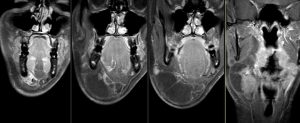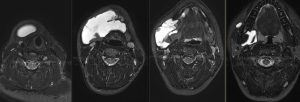About Us
22 year-old with a 3 year history of fluctuating submandibular region lump

Axial T1 noncontrast

Coronal T1 fat sat post Gad

Axial STIR

Lateral and frontal fluoroscopic images pre and post sclerotherapy procedure with Sotradecol and then ethanol.
Findings:
Loculated right submental mass which resides mostly in the submandibular space displacing the mylohyoid muscle and adjacent anterior belly of the digastric muscle that extends to the floor of mouth, as well as the posterior margin of sublingual gland
DDX:
lymphangioma, ranula, cystic tumor, epidermoid
Diagnosis:
Lymphangioma
Discussion:
Lymphangiomas are uncommon, hamartomatous, congenital malformations of the lymphatic system that involve the skin and subcutaneous tissues. Lymphatic malformations can be categorized as superficial cutaneous lymphangioma, cavernous lymphangioma, cystic hygroma, or diffuse systemic lymphangioma. The most common sites are the head and the neck, followed by the proximal extremities, the buttocks, and the trunk. Pathogenesis in uncertain but may arise from a primitive lymph sac that fails to connect with the rest of the lymphatic system during its embryonic development. It is rare for lymphangiomas to make their initial presentation during adulthood. Approximately 60% of lymphangiomas are present at birth, and up to 90% are detectable by 2 years of age
Submitted by Asako Miyakoshi, MD, UW Neuroradiology